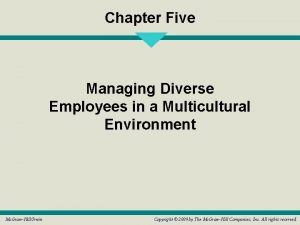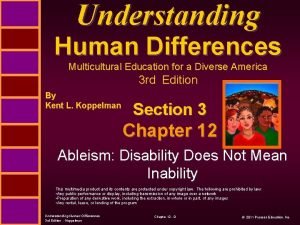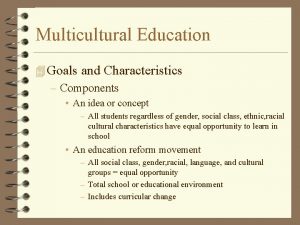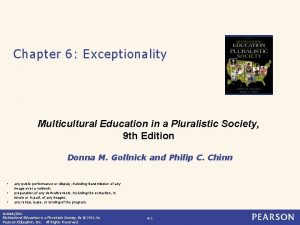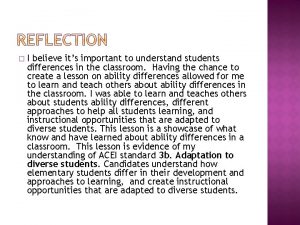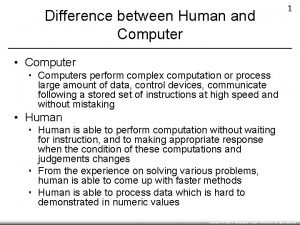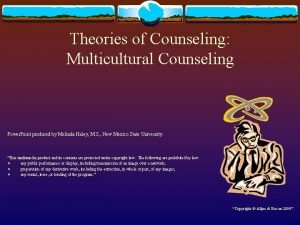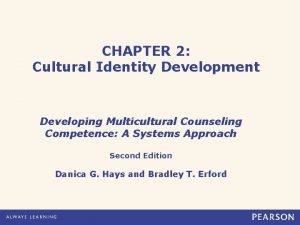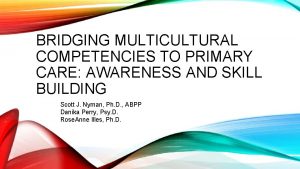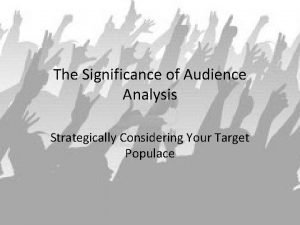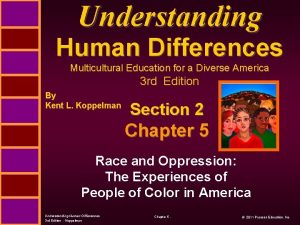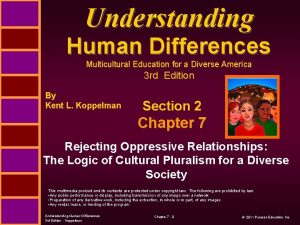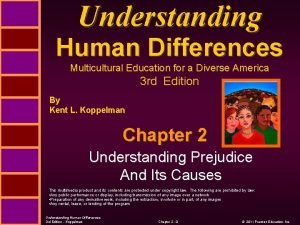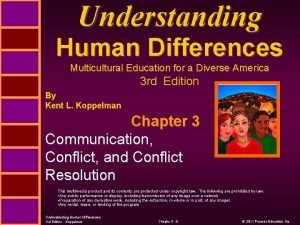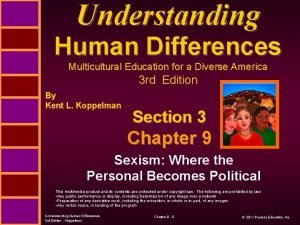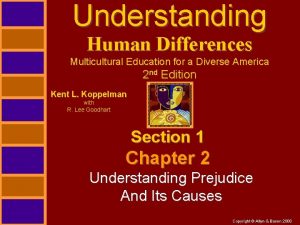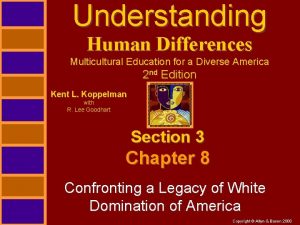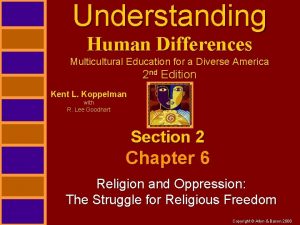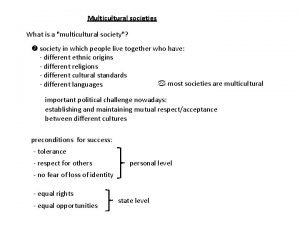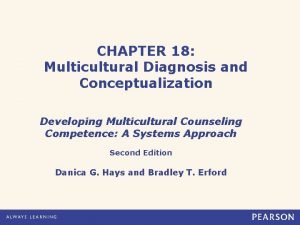Understanding Human Differences Multicultural Education for a Diverse



























- Slides: 27

Understanding Human Differences Multicultural Education for a Diverse America 3 rd Edition By Kent L. Koppelman Section 3 Chapter 12 Ableism: Disability Does Not Mean Inability This multimedia product and its contents are protected under copyright law. The following are prohibited by law: • Any public performance or display, including transmission of any image over a network • Preparation of any derivative work, including the extraction, in whole or in part, of any images • Any rental, lease, or lending of the program Understanding Human Differences 3 rd Edition - Koppelman Chapter 12 - 0 © 2011 Pearson Education, Inc

Understanding Human Differences 3 rd Edition - Koppelman Chapter 12 - 1 © 2011 Pearson Education, Inc

Ableism Refers to the determination of an individual’s abilities based on his or her disabilities; any policy or practice promoting the belief that uses disability to justify discrimination against people with disabilities. (Linton, 1998) Understanding Human Differences 3 rd Edition - Koppelman Chapter 12 - 2 © 2011 Pearson Education, Inc

Why should people with disabilities be considered a MINORITY GROUP • To be a person with disability means the disability influences one’s sense of identity and impacts on daily life • Able-bodied people often have negative reactions to a person’s disability • results in personal rejection and discrimination similar to the experience of members of other minority groups Understanding Human Differences 3 rd Edition - Koppelman Chapter 12 - 3 © 2011 Pearson Education, Inc

Cultural Ableism Refers to a society’s portrayal of people with disabilities as DEVIANT and promoting negative beliefs and images that present people with disabilities as INFERIOR Understanding Human Differences 3 rd Edition - Koppelman Chapter 12 - 4 © 2011 Pearson Education, Inc

What are the HISTORICAL PERCEPTIONS of people with disabilities • Subhuman Organism: • not having the same level of intelligence, emotions, etc. • Diseased Organism: • disability is a defect needing to be cured • Object of Dread: • viewed as defective, perhaps a punishment from God Understanding Human Differences 3 rd Edition - Koppelman Chapter 12 - 5 © 2011 Pearson Education, Inc

• Object of Pity: • viewed as helpless, dependent, incapable • Object of Ridicule: • subjected to name calling (retard) and humor (moron jokes) • Holy Innocent/Eternal Child: • can never become a capable adult • Menace to Society: • perceived as violent, portrayed as villains (Captain Hook) Understanding Human Differences 3 rd Edition - Koppelman Chapter 12 - 6 © 2011 Pearson Education, Inc

What is a disability culture When people with a common disability share: • A historical knowledge • A common language • A cultural identity with norms for behavior • A network of social organizations Example: Deaf Culture Understanding Human Differences 3 rd Edition - Koppelman Chapter 12 - 7 © 2011 Pearson Education, Inc

Individual Ableism Refers to negative attitudes and behaviors based on the assumption that someone’s disability results in their level of ability being DEVIANT from the NORM Understanding Human Differences 3 rd Edition - Koppelman Chapter 12 - 8 © 2011 Pearson Education, Inc

How are negative attitudes reflected in the way people with disabilities are described Negative words and phrases create negative attitudes: Crippled Handicapped Impaired Afflicted with… A victim of… Confined to a wheelchair Understanding Human Differences 3 rd Edition - Koppelman Chapter 12 - 9 © 2011 Pearson Education, Inc

What negative ASSUMPTIONS are made about people with disabilities • A disability is a biological problem that must be fixed, not a societal problem • Problems encountered by a person with a disability are a consequence of the disability • People who are “victims” of a disability will never have productive lives Understanding Human Differences 3 rd Edition - Koppelman Chapter 12 - 10 © 2011 Pearson Education, Inc

More negative ASSUMPTIONS • Being disabled is the most significant factor in how people with disabilities view themselves and how they compare themselves with others • Every person with a disability will require assistance Understanding Human Differences 3 rd Edition - Koppelman Chapter 12 - 11 © 2011 Pearson Education, Inc

How have legitimate LABELS been misused • Mentally retarded people diagnosed as severe or profound were viewed as incapable of independent living and were institutionalized • Experts assumed that up to 75% of people with cerebral palsy were retarded (new tools and testing strategies refute this) Understanding Human Differences 3 rd Edition - Koppelman Chapter 12 - 12 © 2011 Pearson Education, Inc

What are current controversies about labeling children • Children of color are over represented in special needs population (blacks are 3 times more likely to be labeled than whites) • Children of color in special education have more restrictive placements Understanding Human Differences 3 rd Edition - Koppelman Chapter 12 - 13 © 2011 Pearson Education, Inc

How can negative attitudes be changed Eliminate negative words like “crippled” and “handicapped” and replace with what is called “PEOPLE FIRST” language: People with epilepsy People with cerebral palsy People with disabilities Understanding Human Differences 3 rd Edition - Koppelman Chapter 12 - 14 © 2011 Pearson Education, Inc

Institutional Ableism Refers to established laws, customs, and practices that SYSTEMATICALLY DISCRIMINATE against people with disabilities Understanding Human Differences 3 rd Edition - Koppelman Chapter 12 - 15 © 2011 Pearson Education, Inc

Why were people with disabilities placed in INSTITUTIONS • In medieval Europe, children with disabilities were placed in monasteries • Some communities confined “deviants” in available buildings (e. g. , leprosaria) • These buildings became mental asylums or “lunatic hospitals” • This practice continued in the U. S. because people with physical, psychological or developmental problems were not wanted out in the community Understanding Human Differences 3 rd Edition - Koppelman Chapter 12 - 16 © 2011 Pearson Education, Inc

How were INSTITUTIONS for people with disabilities established in the U. S. • After the Civil War, communities looked to institutions to address various problems • People with disabilities were institutionalized in hospitals • Administered by individuals with a medical degree • Supposed to rehabilitate clients but merely took care of them Understanding Human Differences 3 rd Edition - Koppelman Chapter 12 - 17 © 2011 Pearson Education, Inc

What evidence exists that negative attitudes prevailed in INSTITUTIONS and in SOCIETY • The EUGENICS movement singled out people with mental or physical disabilities for institutionalization • Many of these institutions were exposed for providing inadequate care for basic human needs • 30 states enacted laws permitting the involuntary STERILIZATION of people labeled “feeble minded” or “mental defectives” Understanding Human Differences 3 rd Edition - Koppelman Chapter 12 - 18 © 2011 Pearson Education, Inc

Are institutions for people with disabilities providing good care today In response to criticism of institutional care and advocacy for NORMALIZATION, many states have passed “DEINSTITUTIONALIZATION” laws These laws are intended to move people with disabilities out of institutions and into communities Understanding Human Differences 3 rd Edition - Koppelman Chapter 12 - 19 © 2011 Pearson Education, Inc

What is the alternative to placing people with disabilities in institutions • Most people with disabilities prefer to live in communities • In family homes • In group homes • Some communities resist allowing group homes in residential areas Understanding Human Differences 3 rd Edition - Koppelman Chapter 12 - 20 © 2011 Pearson Education, Inc

What is the annual COST of the care provided for people with disabilities Minimal cost of an institution = $80, 000 person Minimal cost of a nursing home = $40, 000 person Maximum cost for community placement = $30, 000 person Taxpayers fund over 60% of expenses for people with disabilities living in institutions or nursing homes Understanding Human Differences 3 rd Edition - Koppelman Chapter 12 - 21 © 2011 Pearson Education, Inc

How do other countries respond to the needs of people with disabilities • France, Germany, and Austria provide cash benefits to people with disabilities to pay for their care and monitor that spending • Austria requires employers to hire one worker with a disability for every 25 jobs in the business and fines those who do not meet the goal • Fines fund accommodations in businesses for workers with a disability Understanding Human Differences 3 rd Edition - Koppelman Chapter 12 - 22 © 2011 Pearson Education, Inc

How does the United States GOVERNMENT provide support for people with disabilities • The federal government established the Social Security program in 1935 • Did not include people with disabilities until the 1950 s • In 1990 Congress passed the Americans with Disabilities Act (ADA) to address discrimination against people with disabilities • Has been ineffective Understanding Human Differences 3 rd Edition - Koppelman Chapter 12 - 23 © 2011 Pearson Education, Inc

How does the United States support people with disabilities who want to live INDEPENDENTLY • In 1973, the Supplemental Security income (SSI) program was created to assist people with disabilities • It was only available for those who could prove financial need • Recipients could not earn additional money or they would lose the benefit Understanding Human Differences 3 rd Edition - Koppelman Chapter 12 - 24 © 2011 Pearson Education, Inc

Is there discrimination against disabled people living in communities JOBS Ø Although 66% of working age adults with disabilities want to work rather than rely on SSI, only 26. 6% are employed and 80% are employed by sheltered workshops, which pay less than minimum wage MOBILITY/ACCESSIBILITY Ø 60% of people with disabilities report that their social, recreational, and employment opportunities are limited by lack of accessible public transportation Understanding Human Differences 3 rd Edition - Koppelman Chapter 12 - 25 © 2011 Pearson Education, Inc

HEALTH CARE Ø People with disabilities have difficulty obtaining health insurance Insurance companies screen for “defects” Medicaid is essential (1/3 of people with disabilities chose not to work rather than jeopardize Medicaid coverage) EDUCATION Ø Federal legislation mandates MAINSTREAMING (students with disabilities must be taught in the “least restrictive environment”), but students with disabilities are still segregated Advocates prefer an INCLUSION MODEL that REQUIRES integration of students with disabilities into regular classrooms Understanding Human Differences 3 rd Edition - Koppelman Chapter 12 - 26 © 2011 Pearson Education, Inc
 Managing diverse employees in a multicultural environment
Managing diverse employees in a multicultural environment Animal like protists
Animal like protists Understanding human differences 5th edition
Understanding human differences 5th edition Difference between health education and health promotion
Difference between health education and health promotion Multicultural education in a pluralistic society chapter 1
Multicultural education in a pluralistic society chapter 1 Characteristics of multicultural education
Characteristics of multicultural education Multicultural education in a pluralistic society
Multicultural education in a pluralistic society James banks multicultural education five dimensions
James banks multicultural education five dimensions Sonia nieto multicultural education
Sonia nieto multicultural education Goals of multicultural education
Goals of multicultural education Misconceptions of multicultural education
Misconceptions of multicultural education What is multicultural education
What is multicultural education Bidialecticism
Bidialecticism Understanding student differences
Understanding student differences What is difference between human and computer
What is difference between human and computer Education system in uk and czech republic
Education system in uk and czech republic Feminist therapy ppt
Feminist therapy ppt Multicultural london english
Multicultural london english Lisa skriloff
Lisa skriloff Interviewing in action in a multicultural world
Interviewing in action in a multicultural world Circles of my multicultural self
Circles of my multicultural self Chapter 2 multicultural therapeutic communication
Chapter 2 multicultural therapeutic communication Cultural identity development models
Cultural identity development models Multicultural primary care
Multicultural primary care Albany park multicultural academy
Albany park multicultural academy Multicultural audience analysis
Multicultural audience analysis Courtland c lee
Courtland c lee Multicultural lesson plan example
Multicultural lesson plan example
